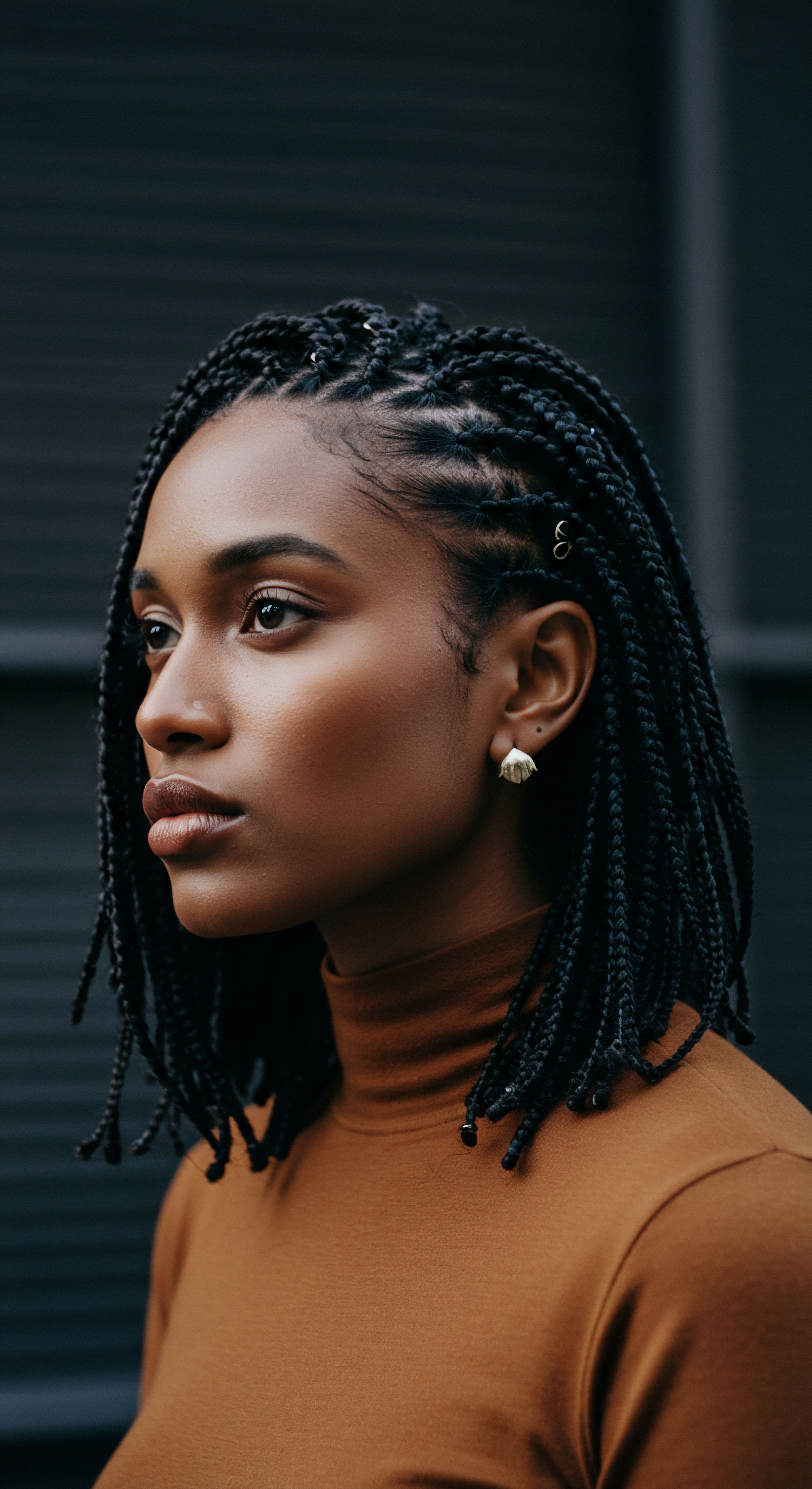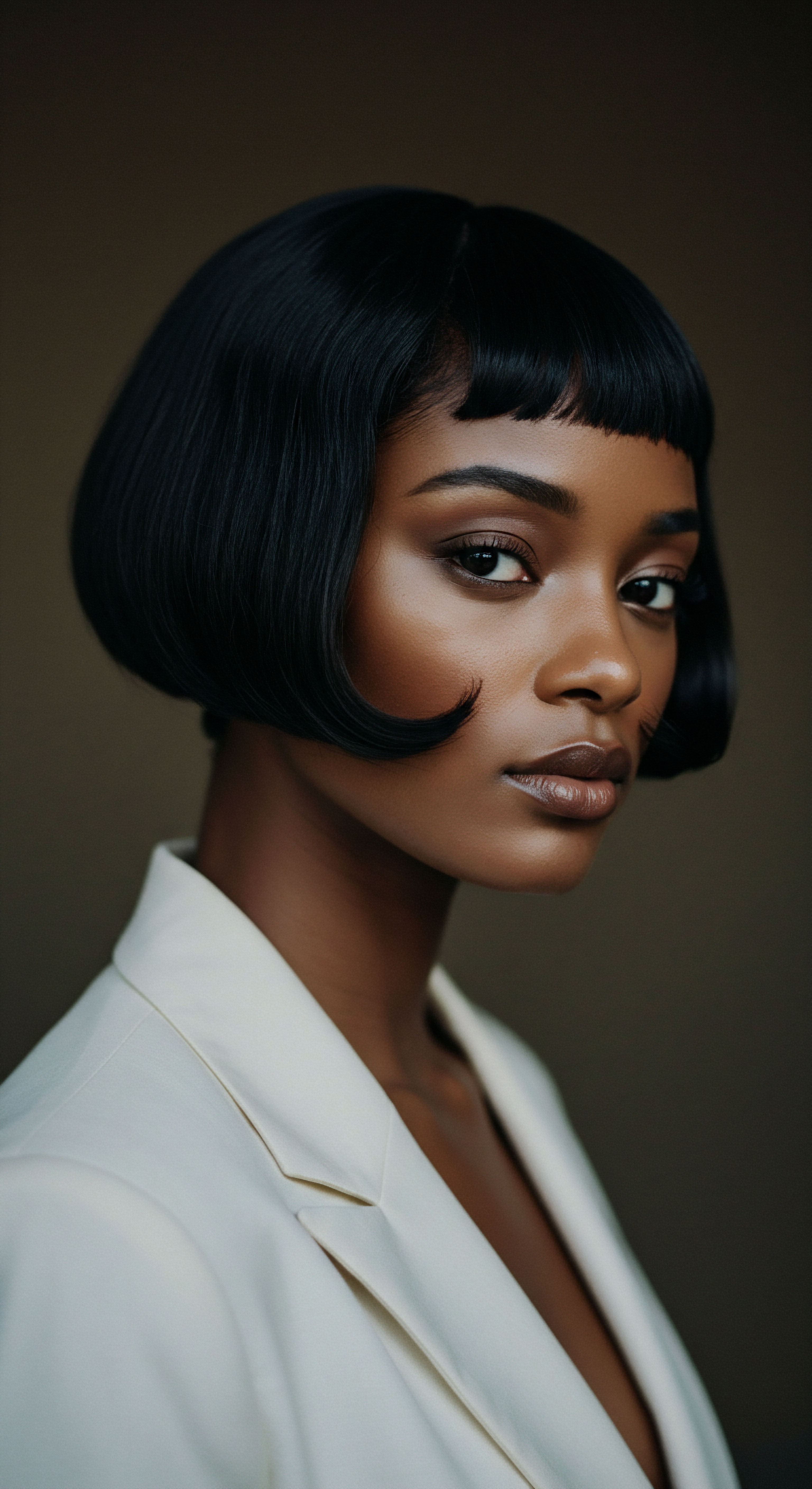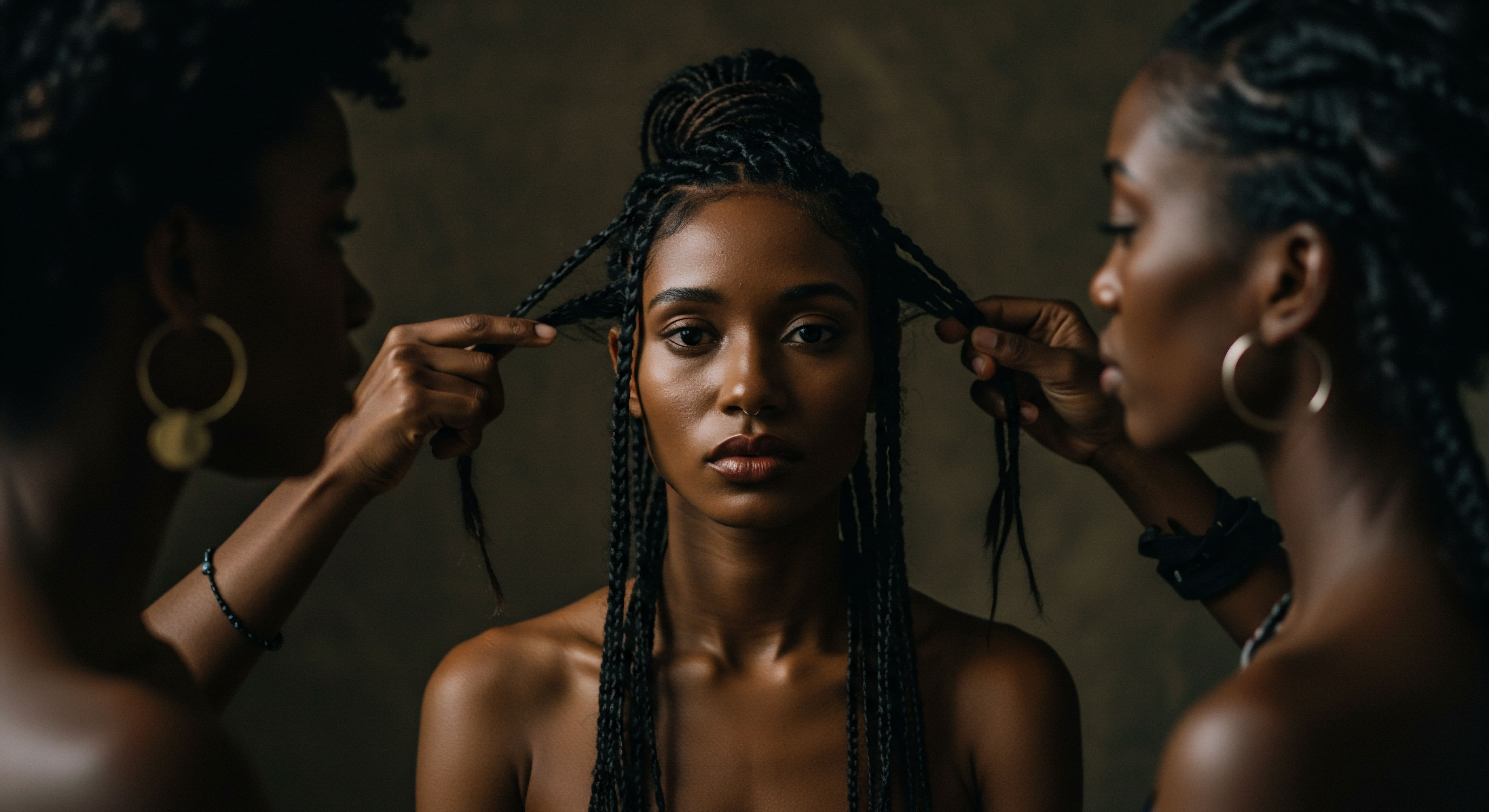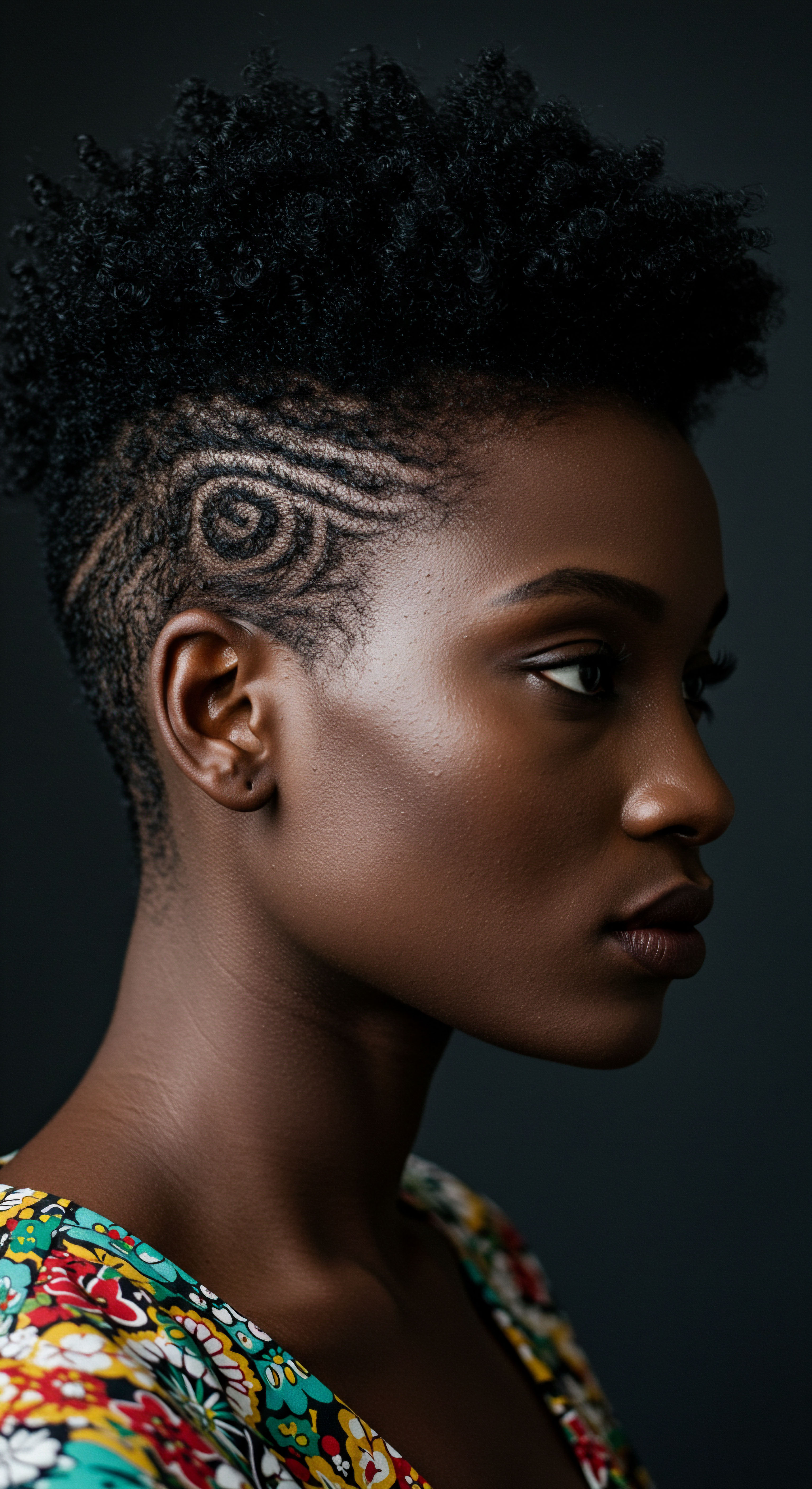
Roots
Consider for a moment the quiet language of hair, a dialogue whispered across millennia, speaking not only of beauty but of belonging, of standing within or without a certain sphere. In the sun-drenched expanse of ancient Egypt, where the Nile’s gentle current mirrored the rhythm of life, hair was never simply an adornment. It served as a profound declaration, a visible scroll unfurling the wearer’s standing in a complex social order. The practices surrounding its care, its styling, and its very presence or absence on the head, offer us a unique lens into the subtle, yet potent, distinctions that shaped daily existence from the grandest palace to the humblest dwelling.
To truly appreciate this ancient discourse, one must first grasp the elemental understanding of hair itself in that distant epoch. It was a canvas, certainly, but also a shield, a symbol of health, and a marker of ritual purity. The dry, arid climate of Egypt posed constant challenges, demanding ingenious solutions for scalp comfort and strand vitality.
From this practical necessity grew a sophisticated approach to hair, one that was inextricably linked to societal roles and expectations. The fundamental differences in how one cared for their hair were not merely aesthetic choices; they were echoes of one’s place in the cosmic and terrestrial order.
Ancient Egyptian hair practices were a visual lexicon, articulating social standing through style, material, and maintenance.

Hair as a Cultural Signifier
In the tapestry of ancient Egyptian life, hair held a position far beyond mere physical appearance. It was a powerful signifier, immediately conveying a person’s identity, age, and crucially, their social strata. A well-kept coiffure, often a wig, spoke volumes of leisure time, access to resources, and freedom from manual labor.
Conversely, a shorn head or simple, practical styling communicated a life of toil, or perhaps, a spiritual devotion demanding purity. This visual shorthand permeated every aspect of society, making the condition and style of one’s hair a silent, yet eloquent, identifier.
The perception of beauty itself was deeply intertwined with hair’s presentation. While our modern sensibilities might view hair as an expression of individuality, in ancient Egypt, its display often adhered to strict conventions dictated by one’s position. The very act of grooming, the ingredients used, and the styles adopted were part of a codified system that reinforced social hierarchy.

The Climate’s Call Protection and Practicalities
The relentless Egyptian sun and ever-present sand presented significant challenges to hair health and scalp comfort. For those who spent their days under the open sky, protection was paramount. Shaving the head or keeping hair very short offered practical benefits, minimizing discomfort from heat and dust, and simplifying hygiene. This practical approach was particularly prevalent among the working classes and those engaged in physically demanding tasks.
For the elite, however, the climate’s demands were met with different solutions. Wigs, often voluminous and intricately styled, provided a layer of insulation against the sun while also allowing for elaborate displays of status. These wigs were not merely decorative; they were functional garments, designed to be removed, cleaned, and re-styled, offering a level of hygiene and comfort that natural hair might not always afford in such an environment. The development of sophisticated hair care preparations, from conditioning oils to perfumed cones, also speaks to a deep understanding of hair’s needs in this unique climate.

Early Hair Treatments Basic Preparations
The ancient Egyptians were remarkably adept at creating a range of preparations for hair and scalp care, utilizing ingredients readily available from their natural surroundings. These early treatments formed the foundation of their hair practices, though the quality and rarity of components varied significantly with social standing.
- Castor Oil ❉ Often used for conditioning and promoting growth.
- Almond Oil ❉ Prized for its emollient properties, helping to soften and add sheen.
- Animal Fats ❉ Such as beef fat or hippopotamus fat, served as bases for pomades and ointments, providing hold and moisture.
For the general populace, these basic preparations would have been simpler, perhaps relying on readily accessible plant oils or animal fats rendered from daily sustenance. The focus would have been on practical benefits ❉ relief from dryness, pest deterrence, and basic grooming.
The elite, conversely, had access to more refined and exotic ingredients. Myrrh, frankincense, and various aromatic resins, imported from distant lands, were incorporated into their hair preparations, transforming basic care into a luxurious, perfumed ritual. These ingredients not only served a cosmetic purpose but also contributed to the preservation of wigs and natural hair, allowing for more elaborate and long-lasting styles.
| Aspect Health and Vitality |
| Significance Lustrous hair indicated well-being and favor. |
| Social Implication Associated with those who could afford proper nutrition and care. |
| Aspect Purity and Cleanliness |
| Significance Shaving or meticulous grooming linked to ritual purity. |
| Social Implication Priests and elite, for whom cleanliness was paramount. |
| Aspect Status and Wealth |
| Significance Elaborate wigs and perfumed cones displayed affluence. |
| Social Implication Reserved for royalty and the wealthy class. |
| Aspect Mourning |
| Significance Neglecting hair or cutting it short could signify grief. |
| Social Implication A temporary alteration, transcending class during periods of loss. |
| Aspect Hair was a multifaceted symbol, its meaning shaped by context and social position. |

Ritual
Stepping from the fundamental understanding of hair’s significance, we now turn to the deliberate choices and daily practices that shaped its presentation in ancient Egypt. Consider the careful hands that braided, the smooth glint of a bronze razor, the lingering scent of precious oils. These were not random acts but components of deeply ingrained rituals, reflecting not only personal aesthetic but, more tellingly, one’s station within society. The distinction in hair practices was not merely about possessing more or less; it was about the very nature of the care, the time dedicated, and the artistry applied.
For some, the morning ritual might involve a quick shave and a practical head covering; for others, it was a leisurely affair, attended by servants, culminating in an elaborate coiffure that would command attention. This divergence in daily habits speaks volumes about the economic realities and social expectations that governed individual lives. The rhythm of hair care, from cleansing to styling, was a direct echo of the broader societal symphony.

The Elite’s Elaborate Adornments
The upper echelons of ancient Egyptian society, particularly royalty and high-ranking officials, transformed hair adornment into an art form. Their practices revolved around the use of wigs , which were far more than simple hairpieces. These were meticulously crafted objects, often fashioned from human hair, palm fibers, or even vegetable fibers, intricately braided and styled. The wigs provided protection from the sun, allowed for easy removal for hygiene, and most importantly, served as powerful visual markers of wealth and authority.
The preparation of these wigs involved specialized artisans, highlighting the economic investment required. They were often adorned with gold ornaments, beads, and ribbons, further emphasizing the wearer’s status. For instance, the wigs of queens and pharaohs, as seen in tomb paintings and surviving artifacts, display incredible complexity, with numerous braids, curls, and layers, often culminating in elaborate styles that would have been impossible to maintain with natural hair alone.
The elite’s reliance on intricate wigs underscored their social standing, leisure, and access to skilled artisans.
A defining element of elite hair ritual was the use of scented cones , often depicted atop the heads of banqueters and high-status individuals in tomb art. These cones, typically made of animal fat infused with aromatic resins like myrrh or frankincense, would slowly melt throughout the day, releasing their perfume and conditioning the wig or natural hair beneath. This practice speaks to a culture that valued fragrance and luxurious self-presentation as much as visual splendor. The rarity and cost of the ingredients within these cones further restricted their use to the privileged few.

Common Strands and Daily Practices
The hair practices of the general populace presented a stark contrast to the opulence of the elite. For laborers, farmers, and artisans, practicality and hygiene were the guiding principles. Many men, particularly those engaged in physically demanding work, opted to shave their heads completely or keep their hair very short. This was a sensible choice for comfort in the hot climate and for maintaining cleanliness, as it minimized the accumulation of dust and pests.
Women of the lower and middle classes typically wore their natural hair, often styled in simple braids or short, practical cuts. While they still engaged in basic grooming, their resources were limited. They might use more common plant oils, like castor or olive oil, for conditioning, and their styling tools would have been rudimentary. Adornments, if any, would have been simple beads or woven bands, rather than precious metals.
Children across all social strata often had their heads shaved, with the notable exception of the “sidelock of youth.” This single lock of hair, usually on the right side of the head, was a common symbol of childhood and was eventually shorn upon reaching adolescence. This practice, while appearing in all classes, would have been maintained with varying degrees of care and cleanliness depending on the family’s resources.

Tools of the Trade A Social Divide
The implements used for hair care also reflected social distinctions. While everyone needed basic tools, the materials and craftsmanship of these tools varied significantly.
- Combs ❉ Elite individuals possessed combs crafted from precious materials such as ivory, polished wood, or even gold. These were often finely carved and highly decorative, reflecting their owner’s taste and wealth. Commoners, by contrast, used combs made from simpler wood or bone, often less refined in their construction.
- Razors ❉ Shaving was a widespread practice, particularly for men and priests. The elite used finely honed bronze razors, sometimes with decorative handles, indicating superior metalworking and personal wealth. Lower classes would have relied on less refined bronze tools or even sharp flint blades, which, while effective, lacked the elegance and durability of the elite’s instruments.
- Tweezers and Hairpins ❉ These smaller tools were also subject to class-based variations. Tweezers for removing unwanted hair, and hairpins for securing styles, would have been made from bronze or copper for the wealthy, while simpler, less durable materials were common for others.
The very act of acquiring and maintaining these tools was a subtle indicator of one’s place. The wealthy could afford specialized artisans for their tools, ensuring their longevity and aesthetic appeal, while the working class relied on more utilitarian, self-made, or mass-produced implements.
| Tool Type Combs |
| Elite Access and Features Ivory, polished wood, ornate carvings, fine teeth. |
| Commoner Access and Features Simple wood, bone, less refined, functional. |
| Tool Type Razors |
| Elite Access and Features Finely ground bronze, sometimes gold-plated handles, sharp edges. |
| Commoner Access and Features Rougher bronze, flint, utilitarian design. |
| Tool Type Hairpins/Accessories |
| Elite Access and Features Gold, silver, bronze, intricate designs, precious stones. |
| Commoner Access and Features Bone, wood, simple copper, plain or basic ornamentation. |
| Tool Type Styling Aids |
| Elite Access and Features Scented oils, rare resins, perfumed cones. |
| Commoner Access and Features Basic plant oils, animal fats, less refined substances. |
| Tool Type The materials and artistry of hair tools directly correlated with social standing. |

Relay
As we consider the threads that bind ancient Egyptian hair practices to their societal fabric, a deeper question arises ❉ How did these seemingly personal choices about hair reflect and reinforce the very structure of their world, reaching beyond mere aesthetics into the realms of health, economy, and power? It is here, in this more intricate exploration, that the true complexity of their hair culture comes to light, revealing layers of meaning that speak to a civilization profoundly ordered and symbolic. We are not simply observing how hair was styled; we are discerning the subtle ways it participated in the grand ballet of social stratification.
The distinctions in hair care were not accidental; they were deeply embedded in the economic realities and spiritual beliefs of the time. The resources required for certain styles, the labor involved in their maintenance, and the cultural messages they conveyed, all contributed to a sophisticated system of non-verbal communication. To understand this, we must look at the unseen hands that shaped these practices and the broader societal forces that dictated their adoption.

Beyond Adornment Hair as Social Barometer
Hair in ancient Egypt functioned as a potent barometer of social standing, extending beyond simple visual cues. The ability to maintain elaborate wigs, to employ barbers and wig makers, and to afford the rare unguents and perfumes speaks directly to one’s economic capacity and freedom from manual labor. A person with a pristine, voluminous wig, free of pests and meticulously styled, was clearly someone who did not toil in the fields or engage in dusty construction work. This external presentation was a testament to an internal reality of wealth and leisure.
Conversely, the practicality of shaven heads or very short, natural hair for the working classes was a direct consequence of their daily lives. Such styles minimized hygiene issues in a hot, dusty environment and were far less demanding to maintain. The distinction was not a judgment of character but a clear visual representation of one’s daily routine and economic means. This stark difference highlights how deeply practical considerations intersected with social roles.

The Silent Language of Strands
Beyond the practical, hair also conveyed symbolic messages that transcended mere appearance. The sidelock of youth, worn by children, was a universal symbol of childhood, irrespective of social class. Its removal marked the transition to adulthood, a rite of passage observed by all.
However, even this shared symbol could carry class nuances. A wealthy child’s sidelock might be meticulously braided and adorned, while a commoner’s might be simpler, yet its meaning remained the same.
For priests and priestesses, shaving the head was a profound act of ritual purity, a dedication to their divine service. This practice, while seemingly similar to the shaven heads of laborers, carried an entirely different symbolic weight. It was a conscious choice for spiritual cleanliness, setting them apart from both the common populace and the wig-wearing elite, occupying a unique position within the social and religious hierarchy. This demonstrates how a similar physical appearance could signify vastly different social and spiritual statuses.

Economic Currents and Hair’s Worth
The economy of hair in ancient Egypt was surprisingly robust, particularly around the production and maintenance of wigs and hair extensions. This industry created specialized professions ❉ wig makers, barbers, and cosmetic artisans. The demand for human hair, often sourced from slaves or even donated, was significant, driving a micro-economy centered on hair adornment. The elite’s desire for elaborate coiffures fueled this trade, creating opportunities for skilled laborers who, despite their craft, might not have shared the same social standing as their patrons.
The cost of maintaining these elaborate styles was substantial. Regular cleaning, re-styling, and the application of expensive oils and perfumes required continuous expenditure. This constant investment further cemented the visual divide between the classes. The financial burden associated with upper-class hair practices was a silent, yet potent, signal of enduring wealth.
Hair practices in ancient Egypt were deeply intertwined with economic realities, creating specialized labor and highlighting wealth disparities.
Consider the research into the prevalence of parasitic infestations. A study by Roberts et al. (2012) on skeletal remains from various ancient Egyptian sites, including El-Amarna and Gurob, indicated varying rates of head lice. While lice were a common problem across all social strata in ancient populations, the ability to mitigate infestations through consistent grooming and access to clean, removable wigs likely offered a degree of relief to the elite that was unavailable to the general populace.
For instance, the systematic cleaning and airing of wigs, a practice documented in various historical texts and through archaeological finds, would have significantly reduced the presence of parasites compared to natural hair that was less frequently washed or treated due to resource limitations. This subtle difference in hygiene management, enabled by wealth, provides a unique lens into the real-world health implications of social class distinctions in hair care.

Hair and the Afterlife Eternal Styles
The significance of hair extended beyond earthly life into the realm of the afterlife. Mummified remains often show carefully preserved hair or wigs, indicating a belief that one’s appearance in the next world was as important as in this one. The elite were frequently buried with their finest wigs and grooming tools, ensuring their eternal beauty and status. This practice highlights the enduring symbolic value of hair as a marker of identity and prestige, even in death.
For the common people, while elaborate wigs might not have been part of their funerary assemblages, basic hair care or the natural state of their hair would still be preserved as part of the mummification process, reflecting their earthly identity. The presence or absence of specific hair preparations or styling implements in tombs offers archaeologists crucial insights into the social standing of the deceased, providing tangible evidence of the class-based variations we have discussed.

Reflection
The ancient Egyptian approach to hair, in its myriad forms, invites us to consider how deeply our personal presentations are shaped by the larger currents of society, economy, and belief. From the shimmering wigs of queens to the shorn heads of laborers, each strand tells a story not just of individual preference, but of a collective understanding of place and purpose. These ancient practices whisper a timeless truth ❉ hair has always been, and remains, a powerful conduit for identity, a visible testament to the unspoken hierarchies and cherished values that define us.

References
- Roberts, Charlotte A. et al. “A Review of Palaeoparasitology in Egypt ❉ What Can We Learn from Ancient Egyptian Mummified Remains?” Parasitology, vol. 139, no. 14, 2012, pp. 1827-1837.
- Pinch, Geraldine. Egyptian Mythology ❉ A Guide to the Gods, Goddesses, and Traditions of Ancient Egypt. Oxford University Press, 2004.
- Robins, Gay. The Art of Ancient Egypt. Harvard University Press, 2008.
- David, Rosalie. Handbook to Life in Ancient Egypt. Oxford University Press, 1998.
- Shaw, Ian. The Oxford History of Ancient Egypt. Oxford University Press, 2000.
- Germer, Renate. Mummies ❉ Life After Death in Ancient Egypt. Prestel Publishing, 2001.
- Brewer, Douglas J. and Emily Teeter. Ancient Egypt ❉ The Nile and Its People. British Museum Press, 1999.
- Lichtheim, Miriam. Ancient Egyptian Literature ❉ A Book of Readings. University of California Press, 2006.